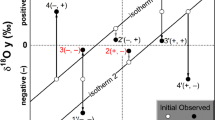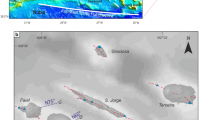Abstract
THE chemical composition of the Hammam Farun hot spring (72° C) in the Suez Rift Valley has been found to be almost identical to that of the Tiberias Hot Springs (60° C) in the Jordan Rift Valley (Figs. 1 and 2 and Table 1). This finding is of vital importance in the evaluation and sorting out of various hypotheses that have been proposed for the origin of the mineral waters in the Jordan Rift Valley. In this valley more than 200 mineral springs and wells are found to have a rather uniform chemical composition, although scattered along a section of 200 km of the valley and issuing from a large variety of rock units and tectonical structures. As a working hypothesis it had been suggested1 that some time in the geological past the ocean invaded temporarily the Jordan Rift Valley (through the Esdarlon Valley) and its waters infiltrated into the tectonically shattered rocks, forming reservoirs of trapped oceanic waters, diluted by various amounts of the then prevailing groundwaters2. These trapped waters of oceanic origin reacted with the various host rocks, losing part of their Mg and Na and occasionally SO4 (biogenic decomposition into H2S), and gaining Ca, Sr, Li, H2S, Br and sometimes SO4 (gypsum dissolution) and Ra (formed continuously by the radioactive decay of normally abundant U and dissolved by the waters rich in Cl). Preliminary experiments on seawater stirred with powdered samples of the prevailing rock types in the Jordan Rift Valley resulted in significant enrichments in Ca, Sr, Li and SO4 and losses of Mg and Na, thus forming waters similar to the kind found in the Jordan and Suez Rift Valleys. The enrichment in Br was not achieved in these experiments but Chave3,4 noted similar enrichments in connate waters, by factors of up to 3 (relative to seawater).
Similar content being viewed by others
References
Mazor, E., and Mero, F., J. Hydrol. (in the press).
Gat, R. J., Mazor, E., and Tzur, Y., J. Hydrol. (in the press).
Chave, K. E., Bull. Amer. Petroleum Geologists, 5, 44 (1960).
White, D. E., in Fluids in Subsurface Environments (Amer. Assoc. of Petroleum Geologists, 1965).
Mero, E., and Saltzman, U., Water Planning for Israel (Publication PN-692, June 1967).
Zak, I., and Freund, R., Israel J. Earth Sci., 5, 15 (1966).
Mazor, E., Rosental, E., and Ekstein, J., J. Hydrol. (in the press).
Author information
Authors and Affiliations
Rights and permissions
About this article
Cite this article
MAZOR, E. Compositional Similarities between Hot Mineral Springs in the Jordan and Suez Rift Valleys. Nature 219, 477–478 (1968). https://doi.org/10.1038/219477a0
Received:
Revised:
Issue Date:
DOI: https://doi.org/10.1038/219477a0
- Springer Nature Limited
This article is cited by
-
Diverse origin of modern dolomite in the Levant
Carbonates and Evaporites (1995)





